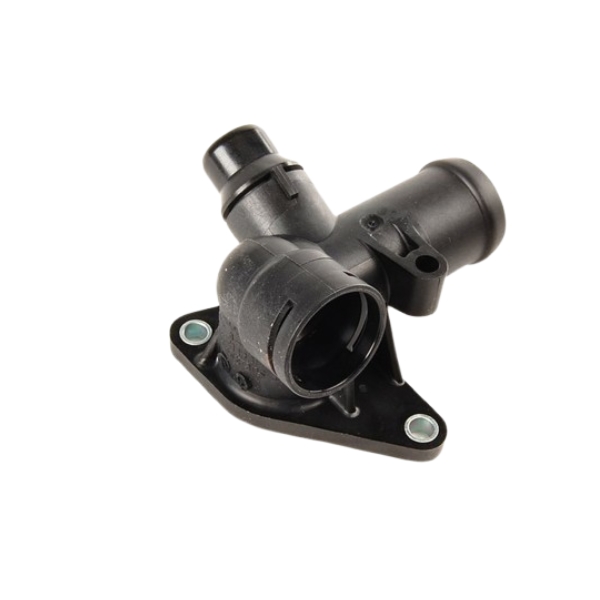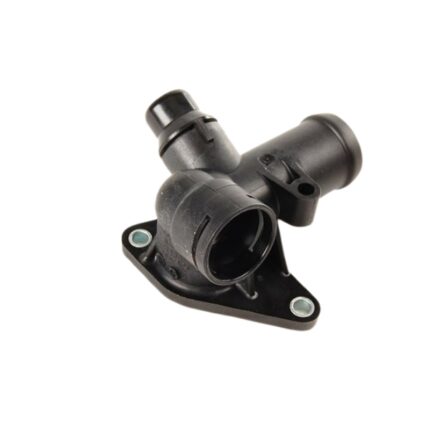Get AUDI B6 A4 FWD 1.8T Cylinder Head Cooling Flange 06B121132E in Kenya
The cylinder head cooling flange is a critical component in an internal combustion engine’s cooling system. Its primary role is to manage the distribution and flow of coolant through the cylinder head, ensuring the engine operates within optimal temperature ranges. This guide provides an in-depth look at the cylinder head cooling flange, including its functions, types, common issues, maintenance, and replacement.
Function of the Cylinder Head Cooling Flange
The cylinder head cooling flange serves several essential functions:
- Coolant Distribution: It channels coolant from the engine block to the cylinder head, ensuring even distribution and preventing hot spots that can cause engine damage.
- Temperature Regulation: By facilitating efficient coolant flow, it helps maintain the engine’s optimal operating temperature, preventing overheating and ensuring efficient combustion.
- Sealing: The flange acts as a sealing interface between the cylinder head and coolant passages, preventing coolant leaks and maintaining proper pressure within the cooling system.
- Support for Sensors and Hoses: Many cooling flanges also serve as mounting points for temperature sensors, coolant hoses, and other components, integrating various elements of the cooling system.
Types of Cylinder Head Cooling Flanges
Cylinder head cooling flanges come in various types and designs, tailored to specific engine configurations and cooling requirements:
- Material Composition:
- Metal Flanges: Typically made from aluminum or steel, these flanges are durable and can withstand high temperatures and pressures. They are commonly used in high-performance and heavy-duty engines.
- Plastic Flanges: Made from high-strength plastic composites, these flanges are lightweight and resistant to corrosion. They are often used in modern engines to reduce weight and manufacturing costs.
- Integrated Components:
- Basic Flanges: Simple designs that primarily serve as a conduit for coolant flow and sealing between components.
- Integrated Sensor Flanges: These flanges include mounts or ports for temperature sensors, helping monitor and regulate engine temperature.
- Multi-Port Flanges: Designed with multiple ports for connecting various coolant hoses and components, ensuring efficient distribution and flow of coolant.
Importance of the Cylinder Head Cooling Flange
The cylinder head cooling flange is vital for several reasons:
- Engine Protection: By ensuring proper coolant flow and distribution, it helps prevent overheating, which can lead to serious engine damage such as warping of the cylinder head, gasket failure, and even engine seizure.
- Performance Efficiency: Maintaining optimal engine temperature is crucial for efficient combustion and performance. A well-functioning cooling flange contributes to better fuel economy, reduced emissions, and overall engine efficiency.
- Longevity of Engine Components: Proper cooling extends the lifespan of engine components by reducing thermal stress and preventing premature wear and failure.
Common Issues with Cylinder Head Cooling Flanges
Several issues can affect the performance and longevity of cylinder head cooling flanges:
- Leaks: Over time, seals and gaskets around the flange can deteriorate, leading to coolant leaks. Leaks can also occur due to cracks or damage to the flange itself.
- Corrosion: Metal flanges are susceptible to corrosion, especially if the coolant is not maintained properly. Corrosion can weaken the flange and lead to leaks or failure.
- Cracking: Plastic flanges can crack due to thermal cycling (repeated heating and cooling) or physical stress. Cracks can lead to coolant leaks and reduced cooling efficiency.
- Sensor Malfunction: Integrated sensors in the flange can fail, leading to inaccurate temperature readings and potentially causing engine overheating or other cooling system issues.
Signs of a Faulty Cylinder Head Cooling Flange
Identifying signs of a faulty cooling flange can help address issues before they lead to more severe problems:
- Coolant Leaks: Visible coolant leaks around the flange or under the vehicle can indicate a problem. Look for puddles or drips of coolant, which is usually green, red, or orange.
- Overheating: Frequent or unexplained engine overheating can be a sign of inadequate coolant flow due to a faulty flange.
- Low Coolant Levels: If the coolant reservoir requires frequent topping up, it could indicate a leak in the cooling flange.
- Temperature Gauge Issues: Erratic or inaccurate readings on the temperature gauge can suggest a problem with the sensor integrated into the cooling flange.
- Steam or Coolant Smell: Seeing steam from the engine bay or smelling coolant (which has a sweet odor) can indicate a leak in the cooling flange.
Maintenance and Prevention
Proper maintenance of the cylinder head cooling flange can help ensure its longevity and effectiveness:
- Regular Inspections: Check the cooling flange and surrounding areas for signs of leaks, corrosion, or damage during routine maintenance.
- Monitor Coolant Levels: Regularly check and maintain proper coolant levels, and use the recommended type of coolant for your vehicle.
- Replace Worn Seals and Gaskets: Over time, seals and gaskets can wear out. Replace them during scheduled maintenance to prevent leaks.
- Flush the Cooling System: Periodically flush the cooling system to remove debris, contaminants, and old coolant, which can help prevent corrosion and build-up that could damage the flange.
- Use Quality Parts: When replacing the cooling flange or related components, use high-quality, OEM (Original Equipment Manufacturer) parts to ensure proper fit and function.
Replacement of the Cylinder Head Cooling Flange
Replacing a cylinder head cooling flange involves several steps, which can vary depending on the engine type and configuration:
- Preparation:
- Tools and Materials: Gather necessary tools, including wrenches, sockets, screwdrivers, and replacement parts.
- Safety Measures: Ensure the engine is cool and the vehicle is securely supported. Drain the coolant from the system to avoid spills.
- Remove Old Flange:
- Locate Flange: Identify the cooling flange on the cylinder head.
- Disconnect Components: Remove any hoses, sensors, or other components connected to the flange.
- Remove Fasteners: Use appropriate tools to remove the bolts or screws securing the flange to the cylinder head.
- Remove Flange: Carefully remove the old flange, taking care not to damage the cylinder head or surrounding components.
- Install New Flange:
- Prepare the Area: Clean the mounting area on the cylinder head to remove any debris, old gasket material, or corrosion.
- Install New Flange: Position the new flange and secure it with the appropriate bolts or screws, tightening them to the manufacturer’s specifications.
- Reconnect Components: Reattach any hoses, sensors, or other components to the new flange.
- Refill Coolant:
- Refill System: Refill the cooling system with the recommended type and amount of coolant.
- Bleed Air: Bleed any air from the cooling system to ensure proper operation and prevent air pockets.
- Check for Leaks:
- Inspect: After installation, check the area around the new flange for any signs of leaks.
- Test Engine: Start the engine and let it run for a few minutes, monitoring for any unusual noises, leaks, or temperature fluctuations.
Follow us on Facebook for more parts.




